Immediate Effect of Hoof Trimming on Hoof and Thoracic Joint Angles in Mangalarga Mares
Abstract
Simple Summary
Abstract
1. Introduction
2. Materials and Methods
3. Results
3.1. Hoof Measurements
3.2. Joint Angles
3.3. Correlations between Hoof Measurements and Joint Angles
4. Discussion
5. Conclusions
Author Contributions
Funding
Institutional Review Board Statement
Informed Consent Statement
Data Availability Statement
Acknowledgments
Conflicts of Interest
References
- O’grady, S.E.; Poupard, D.A. Proper physiologic horseshoeing. Vet. Clin. Equine 2003, 19, 333–351. [Google Scholar] [CrossRef] [PubMed]
- Kummer, M.; Lischer, C. Evaluation of a standardised radiographic technique of the equine hoof. Schweiz. Arch. Für Tierheilkd. 2006, 11, 507–514. [Google Scholar] [CrossRef] [PubMed]
- Floyd, A.; Mansmann, R. Equine Podiatry-E-Book; Elsevier Health Sciences: Amsterdam, The Netherlands, 2007. [Google Scholar]
- Johnston, C.; Back, C. Hoof ground interaction: When biomechanical stimuli challenge the tissues of the distal limb. Equine Vet. J. 2006, 38, 634–641. [Google Scholar] [CrossRef]
- Clayton, H.M.; Gray, O. Effects of barefoot trimming on hoof morphology. Aust. Vet. J. 2011, 89, 305–311. [Google Scholar] [CrossRef]
- Silva, T.O. Descrição Morfológica e da Trajetória Tridimensional dos Cascos de Equinos da Raça Mangalarga Marchador. Master’s Thesis, Universidade Federal de Viçosa, Vicosa, Brazil, 2017. [Google Scholar]
- Heel, M.C.V.; Barneveld, A. Dynamic pressure measurements for the detailed study of hoof balance: The effect of trimming. Equine Vet. J. 2004, 36, 778–782. [Google Scholar] [CrossRef] [PubMed]
- Lesniak, K.; Williams, J. Does a 4–6 week shoeing interval promote optimal foot balance in the working equine? Animals 2017, 7, 29. [Google Scholar] [CrossRef] [PubMed]
- Faramarzi, B.; Nguyen, A. Changes in hoof kinetics and kinematics at walk in response to hoof trimming: Pressure plate assessment. J. Vet. Sci. 2018, 19, 557–562. [Google Scholar] [CrossRef] [PubMed]
- Kelleher, M.E.; Burns, T.D. The Immediate Effect of Routine Hoof Trimming and Shoeing on Horses’ Gait. J. Equine Vet. Sci. 2021, 102, 103633. [Google Scholar] [CrossRef]
- Rosa, V.B.B.; Alonso, J.M. Effect of the trimming of the toe region of healthy horses forelimb hooves on morphology, distal angles and locomotion by cinematography. Arq. Bras. Med. Vet. Zootec. 2022, 74, 234–244. [Google Scholar] [CrossRef]
- Faramarzi, B.; Nelson, S. Evaluating the Effect of Routine Hoof Trimming on Fore and Hind Hooves Impact Phase Kinetics. J. Equine Vet. Sci. 2022, 114, 103935. [Google Scholar] [CrossRef]
- Thomason, J.; Biewener, A. Surface strain on the equine hoof wall in vivo: Implications for the material design and functional morphology of the wall. J. Exp. Biol. 1992, 166, 145–165. [Google Scholar] [CrossRef]
- Moleman, M.; Van Heel, M.C.V. Hoof growth between two shoeing sessions leads to a substantial increase of the moment about the distal, but not the proximal, interphalangeal joint. Equine Vet. J. 2006, 38, 170–174. [Google Scholar] [CrossRef] [PubMed]
- Ribeiro, D.B. O Cavalo: Raças, Qualidades e Defeitos; Globo: Rio de Janeiro, Brazil, 1988; p. 318. [Google Scholar]
- Lage, M.C.G.R. Caracterização Morfométrica, dos Aprumos e do Padrão de Deslocamento de Eqüinos da Raça Mangalarga Marchador e Suas Associações com a Qualidade da Marcha. Ph.D. Thesis, Universidade Federal de Minas Gerais, Belo Horizonte, Brazil, 2001. [Google Scholar]
- White, J.M.; Mellor, D.J. Diagnostic accuracy of digital photography and image analysis for the measurement of foot conformation in the horse. Equine Vet. J. 2008, 40, 623–628. [Google Scholar] [CrossRef] [PubMed]
- Cabral, G.C. Avaliação morfométrica de eqüinos da raça mangalarga marchador: Medidas angulares. Rev. Bras. De Zootec. 2004, 33, 1790–1797. [Google Scholar] [CrossRef][Green Version]
- Godoi, F.N.; Almeida, F.Q. Repeatability of kinematics traits of free jumping in Brazilian sport horses. Livest. Sci. 2014, 168, 1–8. [Google Scholar] [CrossRef]
- Wilson, A.; Agass, R. Foot placement of the equine forelimb: Relationship between foot conformation, foot placement and movement asymmetry. Equine Vetinary J. 2014, 48, 90–96. [Google Scholar] [CrossRef]
- Hood, D.M.; Jackobsen, A.C. The principles of equine hoof wall conformation. In Proceedings of the Hoof Project; Hood, D.M., Wagner, I.P., Jackobsen, A.C., Eds.; Texas A&M University: College Station, TX, USA, 1997; pp. 2–19. [Google Scholar]
- Castelijns, H.H. The basics of farriery as a prelude to therapeutic farriery. Vet. Clin. N. Am. Equine Pract. 2012, 28, 313–331. [Google Scholar] [CrossRef]
- Balch, O.; Butler, D. Hoof balance and lameness: Improper toe length, hoof angle, and mediolateral balance. Compend. Contin. Educ. Pract. Vet. 1995, 17, 1275–1282. [Google Scholar]
- Page, B.T.; Hagen, T.L. Breakover of the hoof and its effect on stuctures and forces within the foot. J. Equine Vet. Sci. 2002, 22, 258–264. [Google Scholar] [CrossRef]
- Hood, D.M.; Taylor, D. Effects of ground surface deformability, trimming, and shoeing on quasistatic hoof loading patterns in horses. Am. J. Vet. Res. 2001, 62, 895–900. [Google Scholar] [CrossRef]
- Baxter, G.M.; Stashak, T.S.; Belknap, J.K.; Parks, A. Adams and Stashak’s Lameness in Horses, 6th ed.; Wiley-Blackwell: Hoboken, NJ, USA, 2011; Chapter 1; p. 1272. [Google Scholar]
- O’Grady, S.E.; Poupard, D.A. Physiological horseshoeing: An overview. Equine Vet. Educ. 2001, 13, 330–334. [Google Scholar] [CrossRef]
- Gill, D.W. Farriery: The Whole Horse Concept: The Enigmas of Hoof Balance Made Clear, 1st ed.; Nottingham University Press: Notingham, UK, 2007; p. 146. [Google Scholar]
- Gordon, S.; Rogers, C. The Forelimb and Hoof Conformation in a Population of Mongolian Horses. J. Equine Vet. Sci. 2013, 33, 90–94. [Google Scholar] [CrossRef]
- Hickman, J.; Humphrey, M. Hickman’s Farriery, 2nd ed.; JA Allen: London, UK, 1988. [Google Scholar]
- Barrey, E. Investigation of the vertical hoof force distribution in the equine forelimb with an instrumented horseboot. Equine Vet. J. Suppl. 1990, 9, 35–38. [Google Scholar] [CrossRef] [PubMed]
- Parks, A. Form and function of the equine digit. Vet. Clin. N. Am. Equine Pract. 2003, 19, 285–307. [Google Scholar] [CrossRef]
- Moyer, W.; Anderson, J.P. Lameness caused by improper shoeing. J. Am. Vet. Med. Assoc. 1975, 166, 47–52. [Google Scholar] [PubMed]
- Silva, A.L.M.M.; Duarte, E.J. Accuracy and agreement between measures of pressure ulcers area through softwares AutoCad® and ImageJ®. Fisioter. Bras. 2014, 15, 248–252. [Google Scholar]
- Elliott, K.; Berry, J.C. A comparison of ImageJ and machine learning based image analysis methods to measure cassava bacterial blight disease severity. Plant Methods 2022, 18, 86. [Google Scholar] [CrossRef]
- Canto, L.S.; Delacôrte, F.D. Frequência de problemas de equilíbrio nos cascos de cavalos Crioulos em treinamento. Braz. J. Vet. Reserch Anim. Sci. 2006, 43, 489–495. [Google Scholar] [CrossRef][Green Version]
- Schade, J.; Baldissera, R. Biometria do equilíbrio podal em equinos de tração pertencentes ao Programa de Extensão “Amigo do Carroceiro” do Centro de Ciências Agroveterinárias da Universidade do Estado de Santa Catarina no município de Lages/SC, Brasil. Ciência Rural 2013, 43, 456–461. [Google Scholar] [CrossRef][Green Version]
- Holroyd, K.; Dixon, J.J.; Mair, T.; Balls, N.; Bolt, D.M.; David, F.; Weller, R. Variation in foot conformation in lame horses with different foot lesions. Vet. J. 2013, 195, 361–365. [Google Scholar] [CrossRef]
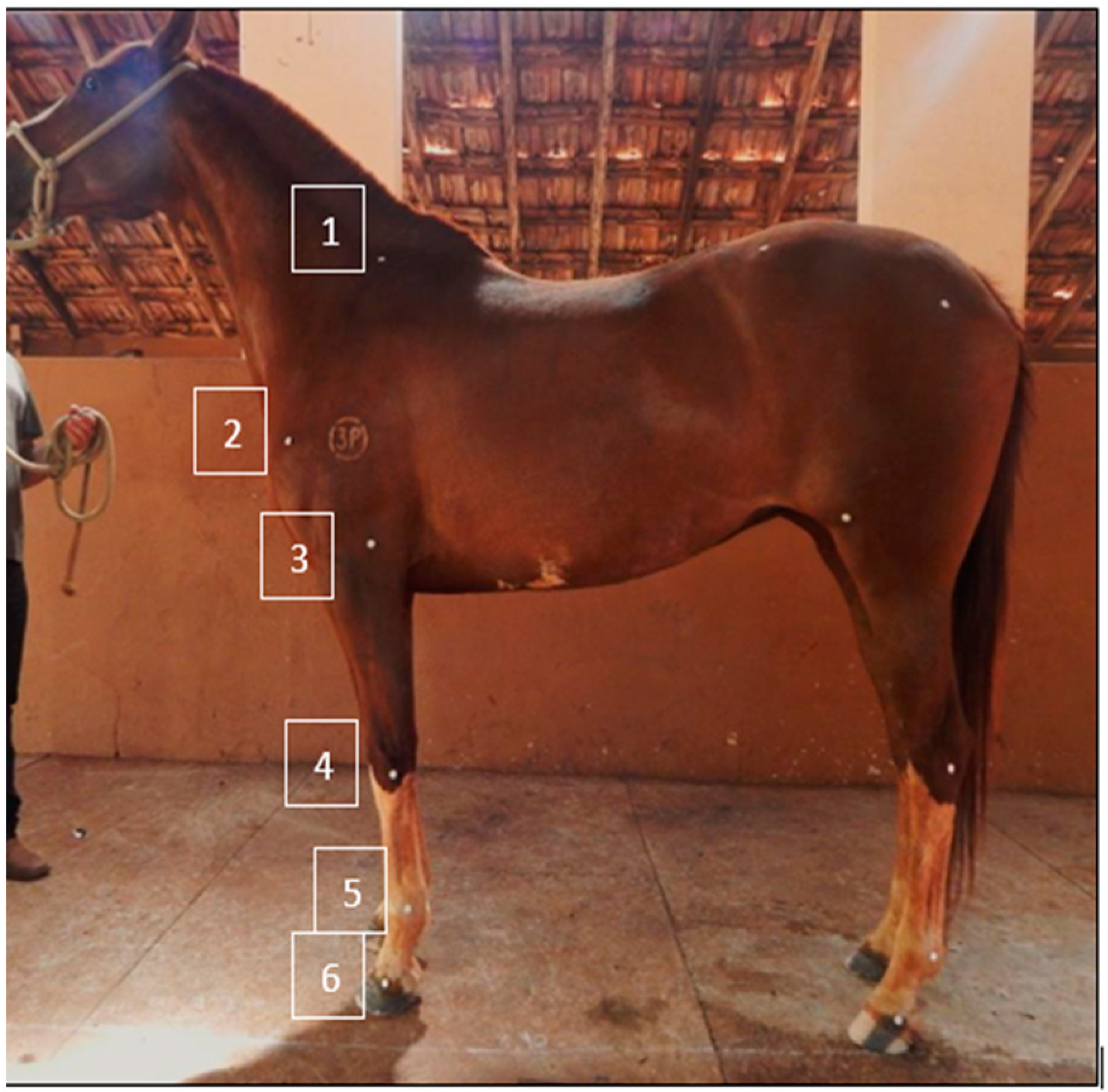
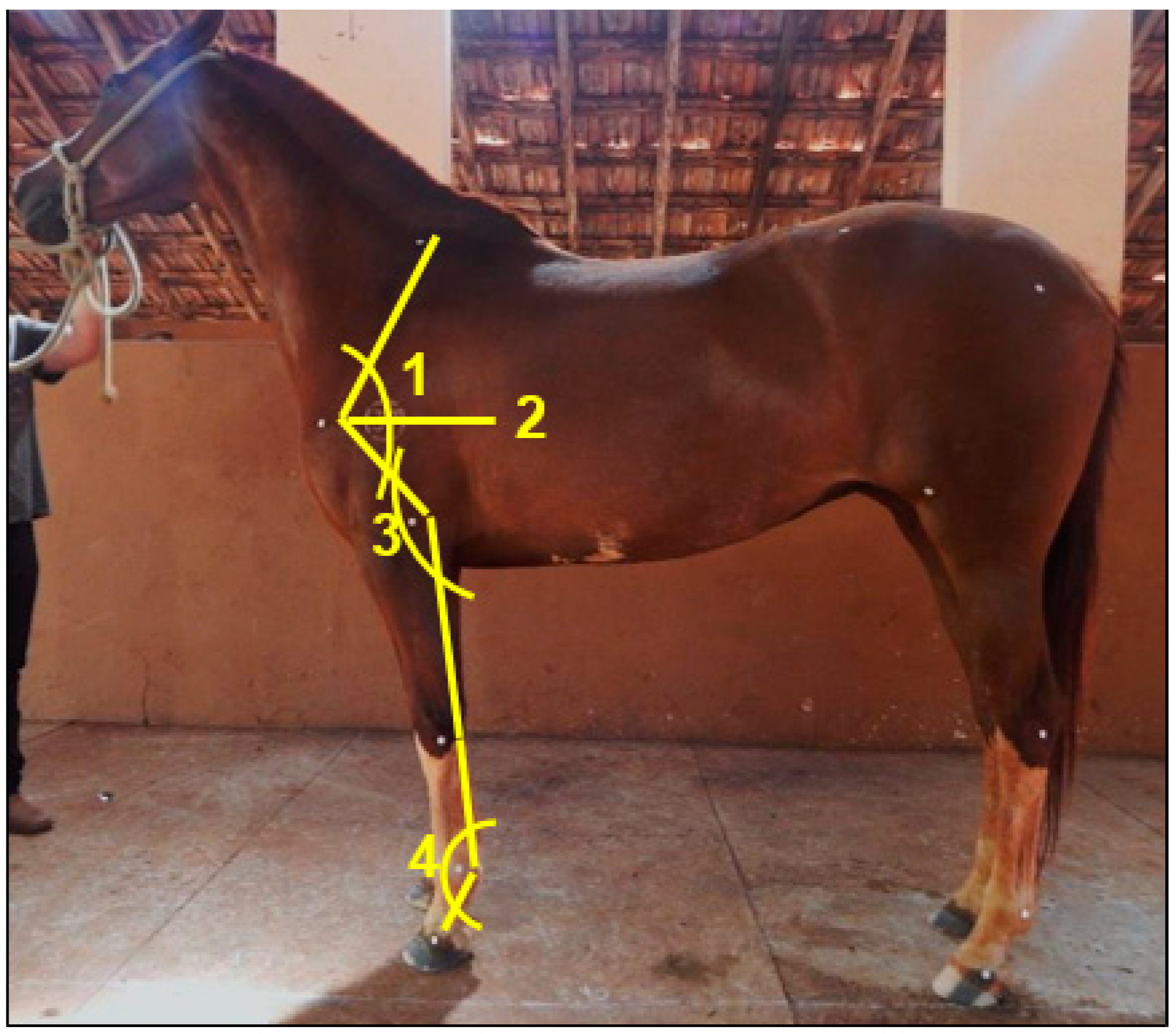

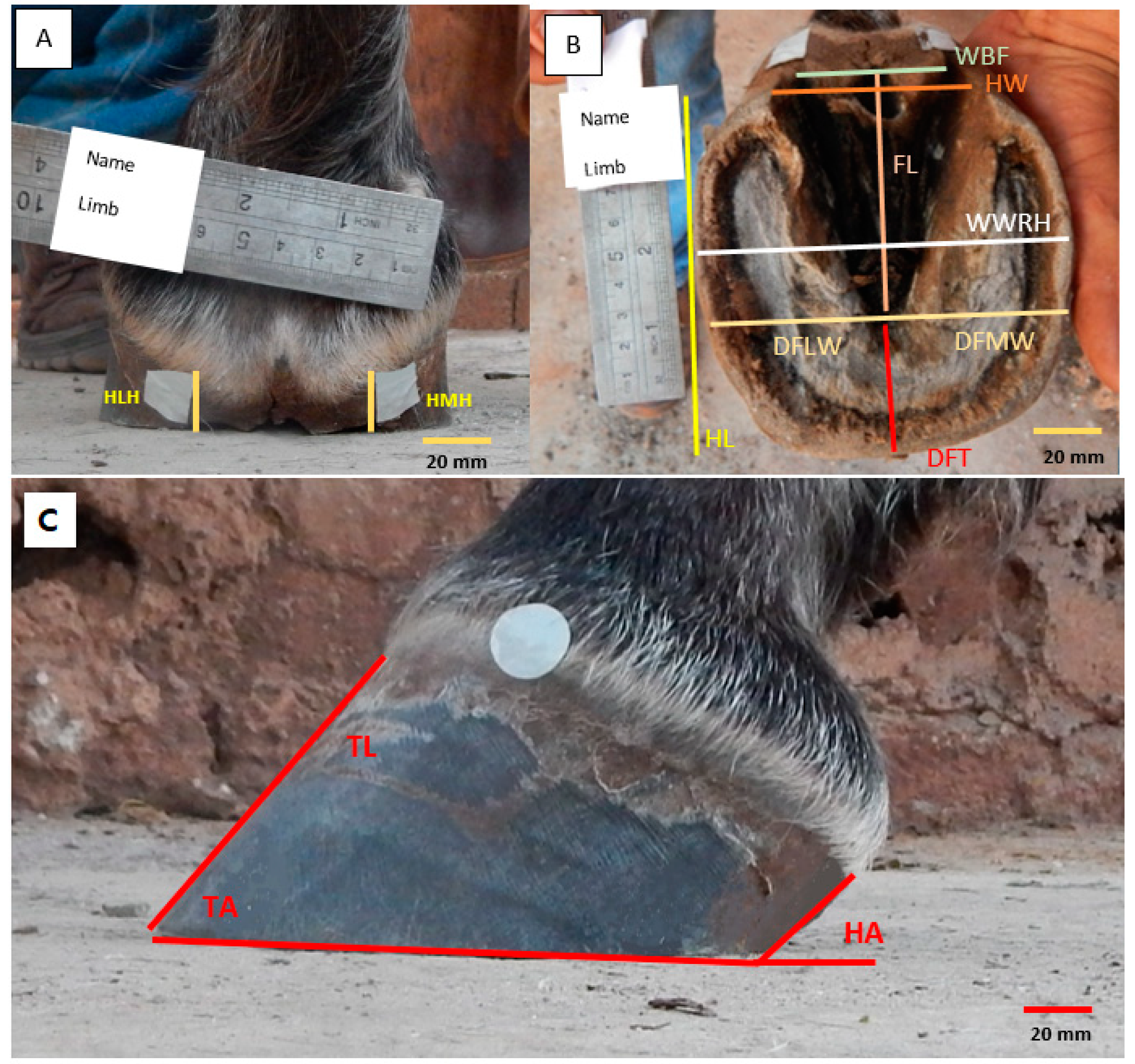
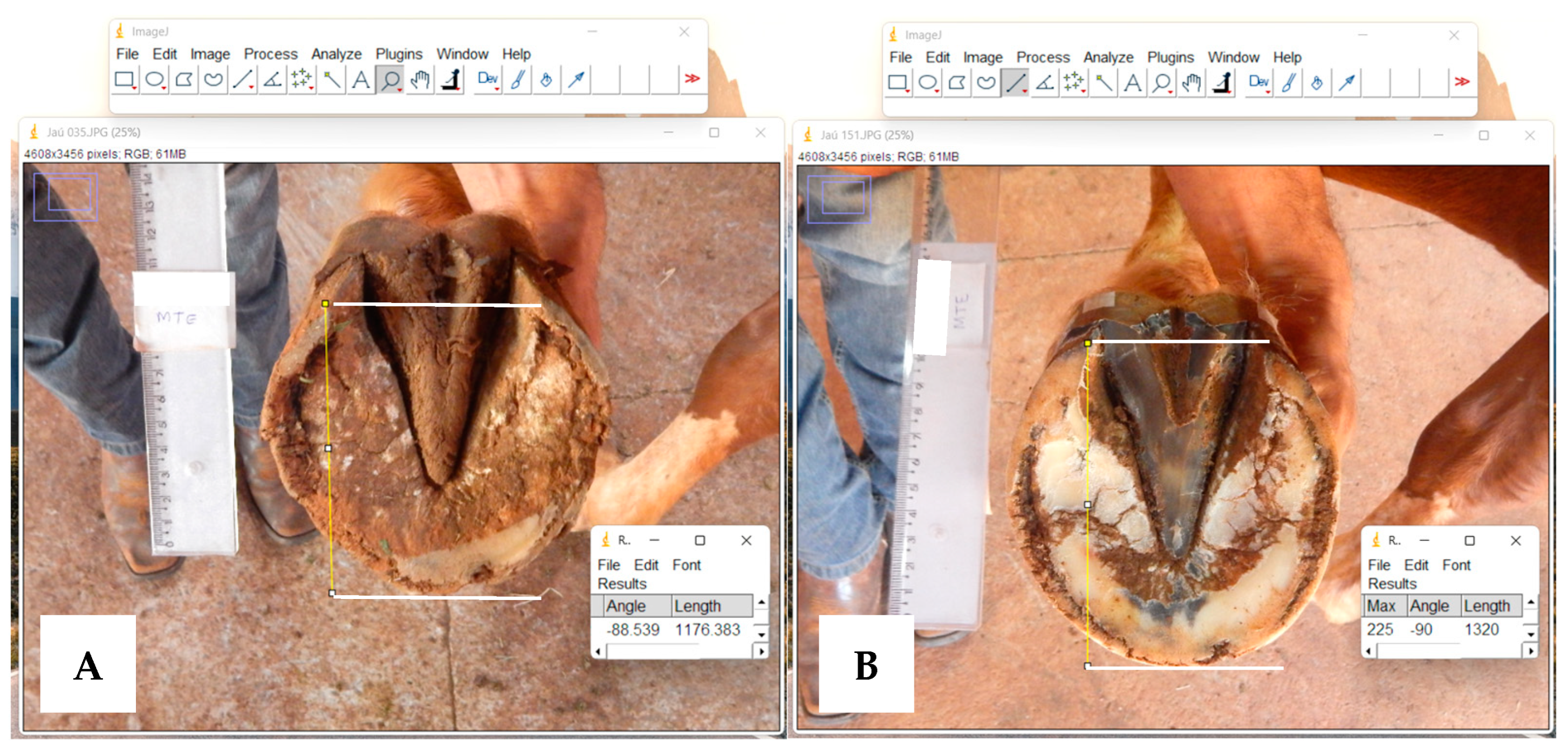
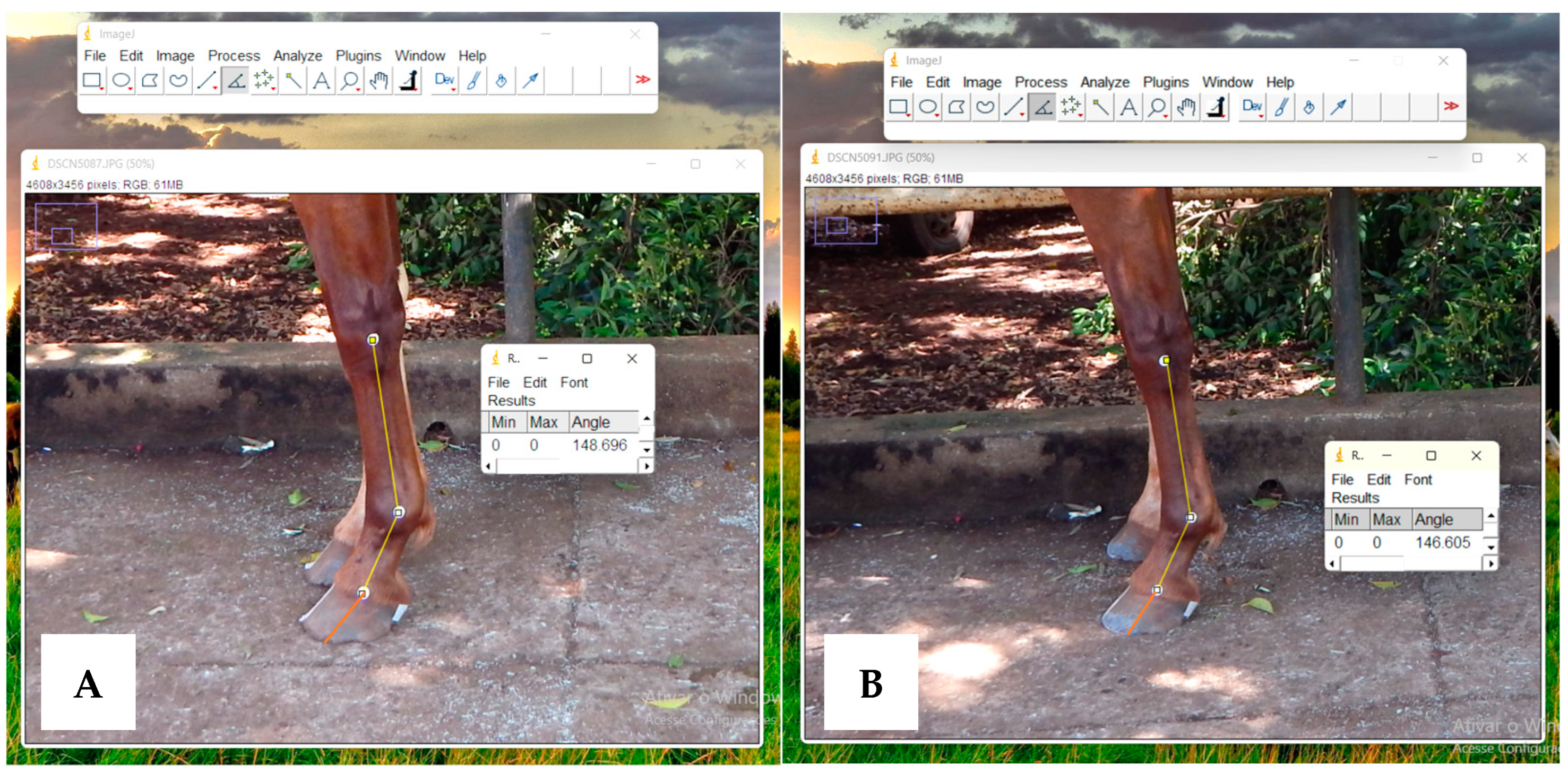
| View | Abbreviation | Description |
|---|---|---|
| Lateral | TL | Toe Length (from the crown of the hoof to the toe) |
| TA | Toe Angle (the angle formed by the hoof wall with the ground) | |
| HA | Heel Angle (from the angle formed by the heel with the ground) | |
| SG | Scapulo-Ground (Angle formed by the scapula and the ground) | |
| SH | Scapulohumeral (Angle formed by the scapula and humerus) | |
| HR | Humeroradial (Angle formed by the humerus and radius) | |
| MCP | Metacarpophalangeal (Angle formed by the metacarpal and the proximal phalanx) | |
| Palmar | HMH | Height of medial heel (from a straight line starting at the hairline of the lateral heel bulb to the ground surface) |
| HLH | Height of lateral heel (from a straight line starting at the hairline of the lateral heel bulb to the ground surface) | |
| HL | Hoof length (the distance between two parallel lines delimiting the most palmar and most dorsal support region of the hoof) | |
| Solar | WBF | Width at the base of the frog (determined by drawing a straight line at the base of the frog) |
| HW | Heel width (the distance between the lateral heel and the medial heel) | |
| DFLW | Distance from the apex of the frog to the lateral wall | |
| DFMW | Distance from the apex of the frog to the medial wall | |
| DFT | Distance from the apex of the frog to the toe | |
| WWRH | Width of the widest region of the hoof (the distance between the medial and lateral walls of the hoof in its widest region) | |
| FL | Frog length (from its base to its apex) |
| Variables | LTL | RTL | ||
|---|---|---|---|---|
| Before-Trim | After-Trim | Before-Trim | After-Trim | |
| HL (cm) | 11.6 ± 0.2 A | 12.3 ± 0.2 B | 11.6 ± 0.2 | 12.3 ± 0.2 |
| WBF (cm) | 5.3 ± 0.1 | 5.1 ± 0.1 | 5.5 ± 0.1 | 5.4 ± 0.1 |
| HW (cm) | 6.4 ± 0.1 | 6.0 ± 0.1 | 6.5 ± 0.1 | 6.3 ± 0.1 |
| FL (cm) | 8.7 ± 0.2 | 8.8 ± 0.2 | 8.6 ± 0.2 | 8.9 ± 0.2 |
| FL (cm) | 8.9 ± 0.1 | 8.4 ± 0.1 | 8.9 ± 0.1 | 8.2 ± 0.1 |
| TA (º) | 49.6 ± 0.3 aA | 50.5 ± 0.3 B | 51.4 ± 0.3 bA | 50.8 ± 0.3 B |
| HA (º) | 50.0 ± 1.0 A | 49.9 ± 1.0 B | 50.7 ± 1.0 A | 50.0 ± 1.0 B |
| HLH (cm) | 3.3 ± 0.0 | 2.7 ± 0.0 | 3.3 ± 0.0 | 2.7 ± 0.0 |
| HMH (cm) | 3.2 ± 0.1 A | 2.7 ± 0.1 B | 3.3 ± 0.1 A | 2.7 ± 0.1 B |
| DFMW (cm) | 5.7 ± 0.1 | 5.6 ± 0.1 | 5.7 ± 0.1 | 5.5 ± 0.1 |
| DFLW(cm) | 5.6 ± 0.1 | 5.6 ± 0.1 | 5.6 ± 0.1 | 5.7 ± 0.1 |
| WWRH(cm) | 12.1 ± 0.2 | 12.0 ± 0.2 | 12.1 ± 0.2 | 12.1 ± 0.2 |
| DTF (cm) | 4.4 ± 0.1 | 4.3 ± 0.1 | 4.3 ± 0.1 | 4.4 ± 0.1 |
| Angles | Before-Trim | After-Trim |
|---|---|---|
| SG (º) | 60.2 ± 4.6 | 58.4 ± 5.8 |
| SH (º) | 108.1 ± 4.2 | 107.7 ± 4.9 |
| HR (º) | 144.6 ± 6.0 | 144.1 ± 6.3 |
| MCP (º) | 146.3 ± 6.0 a | 143.5 ± 6.3 b |
| Variables | Before-Trim | After-Trim | |||
|---|---|---|---|---|---|
| r | p | r | p | ||
| HMH | HLH | 0.534 * | 0.019 | 0.647 ** | 0.003 |
| HL | HMH | −0.499 * | 0.030 | −0.144 | 0.557 |
| DFT | HL | 0.571 * | 0.011 | 0.808 *** | <0.001 |
| WWRH | HMH | −0.544 * | 0.016 | −0.470 * | 0.042 |
| HW | HL | 0.467 * | 0.044 | 0.561 * | 0.013 |
| HW | WWRH | 0.503 * | 0.028 | 0.626 ** | 0.004 |
| WBF | HL | 0.503 * | 0.028 | 0.406 | 0.085 |
| WBF | WWRH | 0.584 ** | 0.009 | 0.522 * | 0.022 |
| WBF | HW | 0.942 *** | <0.001 | 0.927 *** | <0.001 |
| DFLW | WWRH | 0.526 * | 0.021 | 0.736 *** | <0.001 |
| DFMW | WWRH | 0.544 * | 0.016 | 0.843 *** | <0.001 |
| DFMW | DFLW | 0.697 *** | <0.001 | 0.811 *** | <0.001 |
| SH | FL | −0.457 * | 0.049 | −0.202 | 0.407 |
| SH | DFLW | 0.690 ** | 0.001 | −0.245 | 0.312 |
| HA | HLH | 0.493 * | 0.032 | 0.405 | 0.085 |
| TL | FL | 0.506 * | 0.027 | 0.592 ** | 0.008 |
| TL | SG | −0.553 * | 0.014 | −0.363 | 0.127 |
| TA | HLH | 0.472 * | 0.041 | 0.094 | 0.702 |
| HMH | HA | 0.253 | 0.295 | 0.617 ** | 0.005 |
| HL | TL | 0.424 | 0.071 | 0.609 ** | 0.006 |
| FL | HL | 0.233 | 0.337 | 0.835 *** | <0.001 |
| DFT | TL | 0.392 | 0.097 | 0.512 * | 0.025 |
| DFT | FL | 0.133 | 0.588 | 0.613 ** | 0.005 |
| DFLW | DFT | −0.339 | 0.155 | 0.468 * | 0.043 |
| DFMW | HL | 0.266 | 0.271 | 0.489 * | 0.034 |
| DFLW | DFT | −0.263 | 0.277 | 0.644 ** | 0.003 |
| WWRH | DFT | 0.051 | 0.837 | 0.651 ** | 0.003 |
| WWRH | HL | 0.362 | 0.128 | 0.703 *** | <0.001 |
| WWRH | FL | 0.319 | 0.183 | 0.651 ** | 0.003 |
| HW | FL | 0.187 | 0.443 | 0.745 *** | <0.001 |
| HW | DFT | 0.384 | 0.105 | 0.506 * | 0.027 |
| HW | DFMW | 0.079 | 0.747 | 0.511 * | 0.026 |
| WBF | FL | 0.284 | 0.238 | 0.614 ** | 0.005 |
| WBF | DFMW | 0.142 | 0.563 | 0.475 * | 0.040 |
| SH | SG | 0.069 | 0.780 | 0.488 * | 0.034 |
| HR | SG | −0.425 | 0.070 | −0.071 | 0.774 |
| MCP | SG | 0.364 | 0.125 | −0.445 | 0.064 |
| MCP | SH | 0.199 | 0.414 | −0.204 | 0.416 |
| HR | SH | 0.547 * | 0.015 | 0.669 ** | 0.002 |
Disclaimer/Publisher’s Note: The statements, opinions and data contained in all publications are solely those of the individual author(s) and contributor(s) and not of MDPI and/or the editor(s). MDPI and/or the editor(s) disclaim responsibility for any injury to people or property resulting from any ideas, methods, instructions or products referred to in the content. |
© 2023 by the authors. Licensee MDPI, Basel, Switzerland. This article is an open access article distributed under the terms and conditions of the Creative Commons Attribution (CC BY) license (https://creativecommons.org/licenses/by/4.0/).
Share and Cite
Antonioli, M.L.; Canola, P.A.; de Carvalho, J.R.G.; Fonseca, M.G.; Ferraz, G.d.C. Immediate Effect of Hoof Trimming on Hoof and Thoracic Joint Angles in Mangalarga Mares. Animals 2023, 13, 2490. https://doi.org/10.3390/ani13152490
Antonioli ML, Canola PA, de Carvalho JRG, Fonseca MG, Ferraz GdC. Immediate Effect of Hoof Trimming on Hoof and Thoracic Joint Angles in Mangalarga Mares. Animals. 2023; 13(15):2490. https://doi.org/10.3390/ani13152490
Chicago/Turabian StyleAntonioli, Marina Lansarini, Paulo Aléscio Canola, Júlia Ribeiro Garcia de Carvalho, Mayara Gonçalves Fonseca, and Guilherme de Camargo Ferraz. 2023. "Immediate Effect of Hoof Trimming on Hoof and Thoracic Joint Angles in Mangalarga Mares" Animals 13, no. 15: 2490. https://doi.org/10.3390/ani13152490
APA StyleAntonioli, M. L., Canola, P. A., de Carvalho, J. R. G., Fonseca, M. G., & Ferraz, G. d. C. (2023). Immediate Effect of Hoof Trimming on Hoof and Thoracic Joint Angles in Mangalarga Mares. Animals, 13(15), 2490. https://doi.org/10.3390/ani13152490








